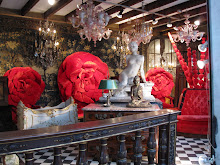Sex and nudity. Murder and lust. War, madness and mayhem. Conspiracies to overthrow the government. We've got all that, and more, here at the Louvre.
If anyone thinks art is boring, think again. The Louvre is filled with 35,000 pieces of art that encompass everything from Adam and Eve getting thrown out of the Garden of Eden to hundreds of depictions of the crucifixion. There are galleries of primitive sculptures of babies at their mothers' breasts to courtyards filled with marble renditions of Roman conquerers. Rows and rows of crown jewels, looking for all the world like props in a play. Happy families and not-so-happy families caught by the painter's brush in everyday scenes. Beauty and horror. In short, the history of the world.
To try to describe the Louvre is nearly impossible. Think canvases as large as mobile homes. Ceilings as high as any cathedral. Gallery after gallery of art catalogued by artist, by century, by geography. Mind-boggling in its scope, the Louvre reminds us who and where we are: tiny specks, privileged to be part of the human experience captured in time throughout the centuries. And thanks to those who thought ahead to collect this art, put it under one roof (thanks, Napoleon) and catalogue it with captions for those of us who weren't paying close enough attention in history class, we have the opportunity to view it--well, at least some of it--during one exhilarating and exhausting day.
While much of Paris quits to the south of France and the Riviera for the month of August, the rest of Europe and beyond considers it their invitation to visit Paris, specifically the Louvre. The place was packed. English and Germans, Italians and Russians, Japanese and Chinese, Aussies and New Zealanders, even the odd American--we were all there to ogle the art but part of the fun was watching each other. Funny, in spite of language barriers you can tell by the body language what's happening. A fussing infant, a truculent teenager, the "I'm-not-going-to-tell-you-again" speech from a parent to an older sibling bent on disturbing the sleep of his baby sister... watching the family dramas play out in other languages was almost as much fun as observing the art.
The Winged Victory has her own showcase at the top of the first staircase and she draws a crowd. People stop dead in their tracks to take photos, causing a four-person pile-up. Venus de Milo and the Laceworker by Vermeer are two of the other large attractions but the biggest of all is the Mona Lisa. Mona has her own room, her own bullet-proof cover and a couple of guards at both sides to boot. People push to the front of the ropes to get a good view and in spite of the hundreds of warnings not to use flash, the room lights up like the red carpet at a Hollywood opening. To my credit, I followed the rules so many of my photos came out yellow and blurry but as the wife of a former museum curator, I can't help it--rules are rules.
Different cultures have different concepts of personal space so I tried not to take it personally when someone jabbed me with an elbow or pushed past me to see the major pieces. In America I think we have a bigger physical "bubble" around us than most cultures, so this feeling of being pressed in might be unique to us. Still, I was struck by the paradox of being transported by this timeless, priceless art and yet piqued by the lack of consideration of others intent on getting their (flash) photos. Before we got to see all 35,000 pieces, it was time to go and it was with some relief that we headed downstairs for the "sortie" (exit) and a cup of that strong, delicious espresso I've come to love.
Friday, August 13, 2010
Subscribe to:
Post Comments (Atom)
































































No comments:
Post a Comment